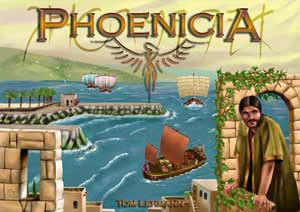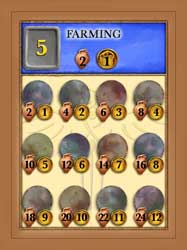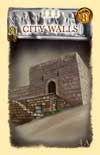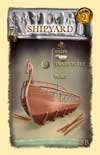Pevans
PhoeniciaReviewed by Pevans |
 It’s impressive how quickly Phoenicia has become popular at my gaming group since its launch – we’ve had three games on the go at once on some evenings. And it’s a well deserved popularity as this is a terrific game. I’d better declare my interest, though. Phoenicia is published by JKLM Games (jointly with Rio Grande Games). I run JKLMnP Distribution, a sister company that distributes JKLM’s games, amongst others. I still think it’s a terrific game.
It’s impressive how quickly Phoenicia has become popular at my gaming group since its launch – we’ve had three games on the go at once on some evenings. And it’s a well deserved popularity as this is a terrific game. I’d better declare my interest, though. Phoenicia is published by JKLM Games (jointly with Rio Grande Games). I run JKLMnP Distribution, a sister company that distributes JKLM’s games, amongst others. I still think it’s a terrific game.
Designer Tom Lehmann set out to come up with a game that reflected the principles of Outpost, but was playable in no more than 90 minutes. As a work in progress, the game has been playtested with gamers for several years. Now we have a finished version of the game so everybody can find out how good it is. It has a historical flavour as players develop their village into a city state in ancient times.
The deep box contains a small board, a large bag of plastic pieces (mostly white, neutral pawns and discs), a substantial deck of cards and a stack of little boards for the players. Each player starts with a set of these little boards in their chosen colour. This reflects their initial status. One board is the training ground where players convert worker pawns from untrained to trained status (at a cost). A trained worker can be deployed to one of the production boards, again, at a cost. Players start with two of these: Hunting and Farming. Each board provides a certain amount of production and a certain number of victory points for each worker on it – these are cumulative through the game. As you’d expect, the cost of placing a worker (buying the tools) is higher the more the board produces.
The final board players start with is their storage, allowing them to hold production cards and coins between turns. They have two warehouses on this at the beginning, allowing them to hold two cards. There is also room for three coins (white discs), with a value of 1, and players start with two each. The cards have a nominal value of 4 – that is, players get one card for each four production points they have. However, most cards are actually worth 5, with some 4s and 6s mixed in. Each player has one card at the start.
At the heart of the game, though, is the deck of development cards. This is split into four sets, which are shuffled separately and stacked on top of each other. It will be no surprise that the first set contains the cheapest and least valuable cards, while the last is made up of the most expensive and most valuable cards. The number of cards in each set depends on how many are playing the game, giving some slightly different tactics depending on whether there are three, four or five players. Each turn as many cards as there are players are available and may be bid for in a series of auctions.
 Each development card does several things. To start with, most of them provide some victory points for their purchaser. Early on this is only a single point, but the value ramps up to 8 points (25% of the way to the winning post) for the most valuable card, ‘City Walls’, in the final set. Cards are thus a major source of victory points. Some cards increase players’ income as well, but the income available is not on the same scale as the victory points. Development cards may give their owners additional production boards or improve current boards. For example, buying a ‘Tracker’ card will flip over the player’s ‘Hunting’ board to give ‘Improved Hunting’, increasing what workers on the board provide. Getting a ‘Prospector’ provides a player with an additional board, ‘Mining’, where workers produce more than they would do as Hunters or Farmers, but cost more to deploy.
Each development card does several things. To start with, most of them provide some victory points for their purchaser. Early on this is only a single point, but the value ramps up to 8 points (25% of the way to the winning post) for the most valuable card, ‘City Walls’, in the final set. Cards are thus a major source of victory points. Some cards increase players’ income as well, but the income available is not on the same scale as the victory points. Development cards may give their owners additional production boards or improve current boards. For example, buying a ‘Tracker’ card will flip over the player’s ‘Hunting’ board to give ‘Improved Hunting’, increasing what workers on the board provide. Getting a ‘Prospector’ provides a player with an additional board, ‘Mining’, where workers produce more than they would do as Hunters or Farmers, but cost more to deploy.
Cards can also provide the purchaser with extra warehouses – which become more and more necessary as a player’s income increases – and more workers, both untrained and, occasionally, trained. Finally, some cards provide a discount on the price of subsequent cards (for example, that Prospector provides a discount on ‘Smelter’, which gives the player an ‘Improved Mining’ board). And having multiple cards gives higher discounts. The sequences of discounts are shown on the main board, along with a grid where players place cubes in their colour to show who has which discounts. Discounts can be very useful because they reduce the player’s need for income.
Several of the discount sequences are significant in terms of players’ strategies. One of these is the ‘Dyer’ card, which provides a discount on the ‘Dye House’ card, which gives players ‘Clothmaking’, the most valuable production board. As well as generating 4 production (= 1 card) and 2 victory points, each worker also gives the player another warehouse for storing that production card. It is also, of course, the most expensive production board in terms of buying the tools for workers. The ‘Shipyard’ cards provide a discount on three different cards, including the second most valuable card, ‘Port’. However, the usefulness of this depends on players getting the chance to buy several of these cards. Finally, the ‘City Center’ card provides a discount on ‘Public Works’, which gives money off ‘City Walls’.
So there are a lot of things to think about in this game and several strategies to try out. There are also a couple of constraints that limit players. One of these is workers. Players start with just three (a Hunter, a Farmer and one untrained). The first set of development cards provides some opportunities to gain more workers, but the next opportunities are not until the third set. A shortage of workers limits a player’s opportunities to increase their production and points. However, there are other strategies and I have seen the game won with only the initial three workers (and have done this myself – once).
The second limitation is storage for holding production cards and coins at the end of a turn. This is crucial as players need funds to bid for development cards and deploy workers. Quite a few cards give players extra warehouses, so these are correspondingly important. The first of these is the ‘Granary’ card, which adds two warehouses and improves the owner’s ‘Storage’ board to allow them to hold up to six coins. This provides an interesting tactical ploy. A player can convert one card to coins at the end of their turn. They can then trade four coins for a card when they receive their production. This will generally give them an extra production point (as cards average 5) at the cost of holding it for a turn – and it’s often better to spend it.
 However, I haven’t told you how a turn works yet. The first player has the option of putting one of the available development cards up for auction. Each card has a minimum initial bid and the bidding goes round the table until only one player is left. The last bidder pays what they bid (less any discount) and takes the card. They mark any victory points and production gained on the track round the main board – each player has two markers, one for points and the other for production. They mark any discounts gained and add or upgrade production boards.
However, I haven’t told you how a turn works yet. The first player has the option of putting one of the available development cards up for auction. Each card has a minimum initial bid and the bidding goes round the table until only one player is left. The last bidder pays what they bid (less any discount) and takes the card. They mark any victory points and production gained on the track round the main board – each player has two markers, one for points and the other for production. They mark any discounts gained and add or upgrade production boards.
Regardless of who bought the card, the player whose turn it is may put another card up for auction. Once they’ve had enough, they can spend any money they have left on deploying workers. Tactical options here include switching workers from one production board to another – for the cost of the tools – or even just paying for training or buying tools (they’re marked so that a trained worker can be placed for no cost later).
The next player gets their turn and may start by putting a card up for auction, if there are any left. In the early stages of the game, resources are tight and it’s unlikely that players will be able to buy more than one card. In the later stages, though, players may well be able to buy more than one and competition can be fierce. As a tactical option, players may choose not to auction anything, but just spend their money on deploying workers. For example, on the first turn players should have seven to spend: just enough to train their worker and place it on Farming to increase their production and points. At the end of their turn, a player must have the storage to hold their remaining cards and coins.
Once all players have completed their turns, the game is over if anybody has reached 32 points or more – and the player with the most points wins the game. If not, the player with the most points becomes ‘Overlord’ – the first player for the next turn – and more development cards are turned over if needed (there will be as many available as there are players in the game). Players then get their production, according to where their marker is on the track. This is shown as a number of cards and any odd coins. By turning in coins to make sets of four, players get extra cards. Thus, with a production level of two cards and two coins (10), a player can hand in two coins to get three cards. When they have their income, players check their storage limitations again. Excess cards are turned into coins and excess coins are lost.
 As you can see, players need to look ahead. You need to make sure that you have the storage to hold your production at the end of the turn so that it is available to spend the following turn. Losing the odd coin here and there won’t be too much of a problem, but having to throw cards away is bad news. This game is about riding the wave of increasing production to build up your position and score the points needed to go past the magic 32.
As you can see, players need to look ahead. You need to make sure that you have the storage to hold your production at the end of the turn so that it is available to spend the following turn. Losing the odd coin here and there won’t be too much of a problem, but having to throw cards away is bad news. This game is about riding the wave of increasing production to build up your position and score the points needed to go past the magic 32.
There is, however, a big element of timing in Phoenicia. What cards appear when provides – or denies – players tactical opportunities. One notable strategy is to buy two (or three in a five-player game) Dyers in order to get a big discount on the Dye Houses. The discount makes it much easier to buy the expensive Dye Houses, each of which provides a substantial increase in production and victory points (and a warehouse) in its own right. While this is a powerful strategy, it’s one that other players can interfere with. And it can go wrong on its own. If a couple of Dye Houses come out at the same time, it’s more difficult for one player to get both of them. Similarly, it can be useful to hang on to production cards from one turn to give you lots to bid with the following turn. But waiting too long for the cards you want will put you at a big disadvantage. It’s not enough to have a strategy, you must react to the tactical circumstances.
The end result is a game that I find enthralling. You know what you need to do to win, the trick is getting the timing right and out-bidding (or out-smarting) the other players. The auctions play an important part here, as they provide a mechanism for balancing the game. You may know what card you want, but the other players can make it too expensive. This makes a game between experienced players finely balanced – what more could you want?
There are some quibbles with the game, mainly in the production. The icons on the cards are rather small, so reading them can be difficult, but the same information is available elsewhere. People have had some problems with the rules, too, though they seem clear enough to me. However, while these may be irritations when first learning the game, they don’t get in the way once you know it. Tom Lehmann has come up with a winner in Phoenicia and it’s a game I’m proud to be selling. It gets 10/10 on my highly subjective scale.
Phoenicia was designed by Tom Lehmann and is published by JKLM Games and Rio Grande Games. It is a strategy board game for 3-5 players, aged 12+, and takes about 90 minutes to play.
This review was first published in the Gamers Alliance Report for Fall 2007.